
Booze, Sailors & Health Menu: 1 2 3 4 5 6 7 8 9 10 11 12 13 14 15 16 17 18 19 Next>>
Booze, Sailors, Pirates and Health In the Golden Age of Piracy, Page 17
The Lesser Penalties of Drunkenness for Sailors
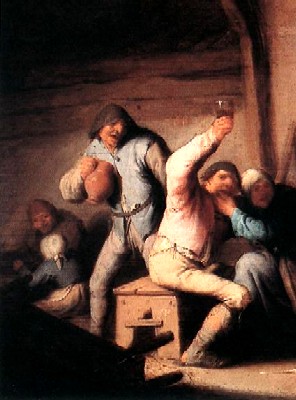
Artist: Adriaen van Ostade (c. 1635)
Intoxication often has a downside as those who have experienced it can attest. (As a matter of fact, I am looking at you.)
This was as true for sailors as anyone else. In some ways, it may have been even more true for sailors since they seemed to indulge frequently.
The tamest punishment that alcohols visits upon the drinker is confusion, sometimes leading to curious outcomes. In a letter by James Howell written to Lord Cliff, he outlines the actions of a group of drunken Dutchmen who "had drunk so deep, beginning to stagger, and their heads turning round, they thought verily they were at Sea, and that the upper-chamber where they were, was a ship; insomuch that it being foul windy weather, they fell to throwing the stools, and other things out of the window, to lighten the vessel for fear of suffering shipwreck."1 (This was much better than drinking causing an actual shipwreck; but let's put a pin in that thought.)
When East Indiaman captain James Macrae's ship Cassandra was taken near Comoros Island by pirates Edward England in the Fancy and John (Richard) Taylor in the Victory, England wanted to spare Macrae while Taylor saw him as a future threat and wanted to kill him. "Mackra [sic] did what he could to soften this Beast, and ply'd him with warm Punch, notwithstanding which they were in a Tumult whether they should make an end of him, or no... Taylor was [eventually] so mellow'd with the Punch, that he consented that the old Pyrate Ship, and so many Bales of Cloth be given to Captain Mackra, and so he fell asleep."2 England told Macrae to leave while Taylor was willing to be so generous, something for which Taylor never really forgave him.
It has already been shown how drunkenness and its after-affect led to the downfall of Bartholomew Roberts. Chaloner Ogle planned his taking of Roberts' pirates carefully, first drawing off his consort ship Ranger by pretending to run away. Because the Ranger's crew were newer, they weren't able to drink punch like the men on Robert's ship Royal Fortune, apparently due to limited supply of sugar. (Not all pirates were equal, despite what the story books tell you.)
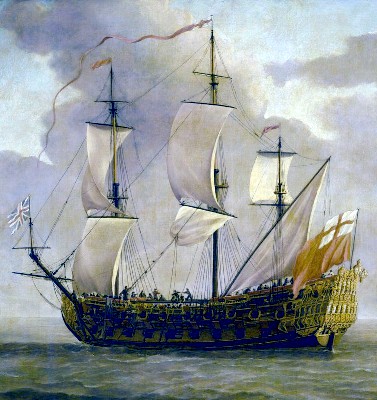
Artist: Willem van de Velde the Elder
A 4th Rate English Warship, HMS Woolwich (1677)
When they saw Ogle's 4th rate Navy ship running away, "every one was willing to believe her [the Swallow] a Portuguese, because Sugar was very much in Demand"3, so Roberts sent the Ranger after her. He explained, "There is, says he, Sugar in the Offing, bring it in, that we may have no more Mumbling"4. Ogle's naval vessel captured them when they were out of sight of the Royal Fortune. He then waited out of sight of Roberts' ship, figuring "the Temptation of Liquor, and Plunder, they might find in this their new Prize [the merchant vessel Neptune], would make the Pyrates very confused, and so it happened."5
Some pirates were suggested to embrace confusion. Blackbeard's (most likely fictional) journal noted that when the men were sober there was " a damn’d Confusion amongst us! - Rogues a plotting. - great Talk of Separation."6 This tongue-in-cheek confusion about what actually caused confusion appears to be Johnson editorializing, but it does indicate how liquor affected the pirates.
Sometimes the confusion created by alcohol resulted in a more significant personal losses, as seen in some other examples from the account of Bartholomew Roberts. Testimony given at the trial of Roberts' men noted that pirate Hugh Harris "was always look’d upon a foolish, crazy, drunken Fellow… he was so ill looked on, that they gave him sometimes a quarter, half, and then a whole Share "7 Robert Lillburn testified that another crew member, John Jessup, was "so drunk they cut him often out of his Share"8. Although his share in the plunder isn't mentioned, testimony stated that Christopher Lang "was a drunken Fellow, and of no Esteem among the Gang, they abusing him, and often calling him drunken Dog, and that they brought him out of the Brigantine for Charity."9
When a sailor got drunk enough, he could get into trouble he otherwise might have avoided had inebriation not encouraged him. A surgeon's mate (assistant) reported that while serving on HMS Vanguard in 1695, he had to treat large "burns resulting from the application of numerous blistering plasters in an attempt to rouse a drunken colleague."10 (This is the only example found of a horrible thing one might do with a drunken sailor. Although
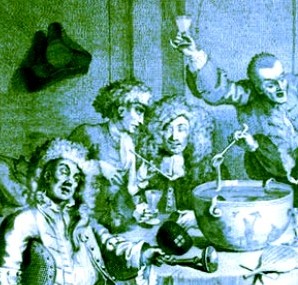
Artist: William Hogarth
Drunk on Punch, From A Midnight Modern Conversation (1730)
the author would certainly be glad to hear of other accounts from the golden age of piracy.)
Drink also made men careless, putting pirates in a position where they might reveal themselves and risk being captured because of their mistake. While on St. Mary's Island in Madagascar in 1719, Captain Lewis of the St. George noted that two men he suspected of being pirates came aboard from the island "whom I plentifully entertained with liquor for three nights to see what might be gathered from them. ...They were very cautious of speaking until drunk when they bragged and told of their loose way of living like so many bravoes [villains]."11
Navyman Samuel Atkins mentioned in his journal on December 8, 1681 that his vessel, HMS Crowne, came upon and English merchant ship in Altea Bay (in Alicante, Spain) to warn him about a Turkish vessel that was about. However, "when wee came on board, wee found ye skipper and y whole company soe drunk that neither by fair nor fowle means wee could make him doe anything for their security. However with our boat's crew, wee clapt her upon a wind with her head to ye shore, and got his owne and our boat a head to tow."12
The suspicious behavior of Walter Kennedy's crew when they reached Ireland and put themselves under the influence has already be noted, but since Johnson mentions it a second time...
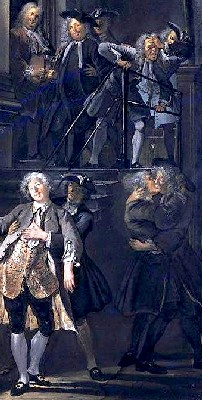
Artist: Cornelis Troost
"Those Who Could Walk Did,
The Others Fell" (1739)
"The whole Company refresh’d themselves at a little Village about five Miles from the Place where they left the Sloop, and passed there for Ship-wreck’d Sailors, and no doubt might have travelled on without Suspicion; but the mad and riotous Manner of their Living on the Road, occasion’d their Journey to be cut short"13.
Canadian-based Mi'kmaq Indian John Baptiste Jedre and four cohorts captured the fishing sloop Tryal in Nova Scotia in August of 1726. The morning after taking the sloop, Jedre "went to Breakfast, and Drank so much, that he knows not how the English overcame the French and Indians on board; but when he came to be sober, he found himself bound in the Hold of the Sloop, and was kept tied till he came to Boston in the Sloop."14
Privateer George Shelvocke said that his crew was stirred into mutiny in July of 1719 by a drink and the fiery rhetoric of his ship's boatswain. However, "next morning I was inform’d, that my people were most of them sorry for what had happen'd the night before [threatening mutiny], laying the blame upon the Boatswain, and too much liquor. …I was fully resolv'd to punish the Boatswain in the severest manner; but was prevail'd on not to do it, he coming in a very humble plight, asking my pardon, and begging that I would not use any severity towards him; for that it was drink that had made him mad, &c."15
Pirate captain John Gilliam and his crew landed in Kathiawar, India to procure fresh water where "the natives primed their visitors so well with country liquor [arrack] and hospitality that they forgot their wonted caution, and were cajoled into shewing their skill with firearms by firing a volley at a mark set up on the beach."16 Once the pirates had emptied their guns, the locals "fell upon them, bound them with ropes, and sent the lot up country to be dealt with by their ruler, who forcibly converted the lot to Mahomedanism, several dying under the operation."17
Alcohol made the sailors careless in other ways as well. Naval chaplain Henry Teonge tells of a dinner with the captain,
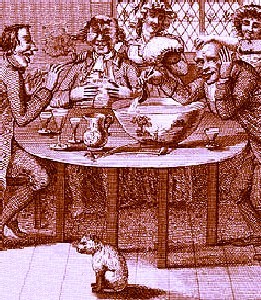
Artist: Samuel Collins
Drinking Punch on Land (1791)
purser, surgeon and another ship's captain at the house of Mr. Low, the Iskenderon English Counsel. There, "wee had a princelike dinnar: and every health that wee dranke, every man broake the glasse he drank in; so that before night wee had destroyd a whole chest of pure Venice glasses"18. Not an inexpensive night for Mr. Low, although he appears to have been happy to participate while under the influence.
Pirates could be even more imprudent while drunk. After escaping a fleet of five vessels, captain John (Richard) Taylor and his crew "caroused, and kept their Christmas in a most riotous manner, destroying most of the fresh provisions they had aboard, of which quite two-thirds was wasted" during three days of intoxicated celebration.19 In addition to being bereft of victuals, Taylor's ship Victory was leaking badly so that they had to make for a port where the vessel could be repaired. "Had it not been for the arrack and the sugar [they had left from their Christmas celebrations], most of them must have perished of hunger and thirst. In this condition they arrived at Mauritius in the middle of February 1721"20.
When William Snelgrave's ship was captured and looted and the men set to drinking heavily, he noted that Howell Davis' and Thomas Cocklyn's pirates "made such Waste and Destruction [of his ship and supplies], that I am sure a numerous set of such Villains would in a short time, have ruined a great City."21 He noted that while the pirates were "all in a drunken Fit, which held as long as the Liquor lasted, no care was taken by anyone to prevent this Destruction [of 'eatables']: Which they repented of when too late."22
When a ship made landfall, consuming too many spirits the night before could cause a sailor to run the risk of reprimand. A Dutchman from Woodes Rogers' privateering voyage had to be roused out of "his Brandy-wine Fit" at a house in Guayaquil, Ecuador by the owner of the house where he fell asleep. The home owner
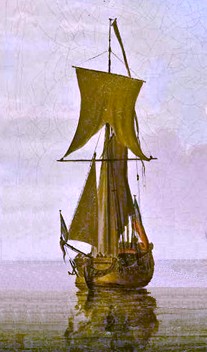
Artist: Peter Monomy (18th c.)
"cautiously seized his Arm, then gently rais'd him, and when his Eyes were open, told him there was his Arms again and bid him hasten aboard to us. This is the only Man that I know of since we took Guiaquil, who had so much transgressed our Orders by drinking beyond his bearing."23
Worse for a land-drunk sailor, he could be left behind, particularly by merchant and privateer ships who had more of a schedule to keep than the pirates and less ability to control the individual crewmen than they navy. There were serious penalties for missing the boat. Edward Barlow explained that when the East India ship Medena was leaving Grand Canary Island, "having several young men ashore ...they, minding their own pleasure more than their business... were left behind on the island and lost the property of their voyage and all their good and clothes on board, and were forced to go back with great charge for England, the ship not staying for them"24.
Even officers could be left behind for failing to make the ship before it left. When the residents of Arica, Chile took their city back from John Watling's buccaneers in 1680, they killed Watling. This caused the previously deposed commodore, Bartholomew Sharp, to resume command and he decided to retreat. Alexandre Exquemelin explained, "He would have brought off our surgeons, but they having been drinking while we assaulted the fort, would not come with us when they were called."25 The surgeons were subsequently made prisoners by the Chileans and surgeon's mate Lionel Wafer was promoted to chief surgeon of the buccaneers' fleet.
Alcohol also encouraged bravado in the face of death, sometimes with unfortunate results. After taking and plundering the merchant vessel Baily, pirate captain George Lowther "sent for the Captain to take a Glass with him; and after
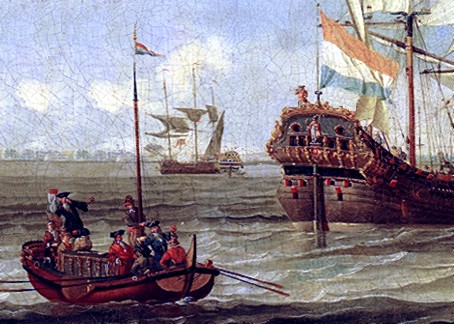
Artist: Abraham Storck (c. 1700)
flourishing his Sword several times over his Head, said, I make no doubt buy you expect to see me make my Exit at Execution-Dock; but by G—I never will, for if I should be over-power’d, here is that shall End me; At which he drew a Pistol from his Girdle."26
In a more tragic case, the alcohol helped convert such a promise into action. Edward Low's pirates mistakenly chased Peter Solgard's Man of War Greyhound, thinking she was a whaler. When they realized their mistake, both Low's crew in the Fancy and Charles Harris's crew in the consort ship Ranger fled, with the Greyhound giving chase. Solgard caught and defeated Harris in the Ranger while Low's ship got away. As reported in the newspapers, "‘Tis very remarkable, that after this Sloop [Ranger], which was taken and had cry’d for Quarter, that one of the Pyrates was seen on Deck with a Flask in his Hand, and having drank and utter’d several Imprecations, he shot himself through the Head."27
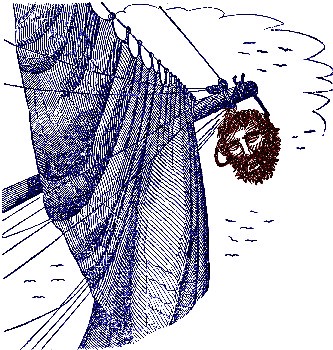
Blackbeard's Head, Pirates Own Book, Charles Ellms (1837)
A pirate vessel tried to take a pair of ships in 1721, only to understand that they were Barbadian pirate hunters. Upon this realization, the captain "asked them, whether they intended to engage him? They answered, Yes. Upon which the Pirate taking up a Bowl of Punch, drank Damnation to him that should give or ask Quarter; which, it’s said, the others pledg’d: and immediately laid him on Board on the Starboard and Larboard side"28. The captain was reported as slain in the ensuing battle.
When Blackbeard was cornered and he determined that two approaching ships "were resolv’d to fight him, he leap’d upon the Round-House of his Sloop, and took a Glass of Liquor, and drank to the Masters of the two Sloops, and bid Damnation seize him that should give Quarter; but notwithstanding his Insolence, the two Sloops soon boarded him, and kill’d all except Teach, and one more, who have been since executed. The Head of Teach is fix’d on a Pole erected for that Purpose."29 After Bartholomew Robert's pirates were captured in Virginia because they behaved so suspiciously, they were sentenced to hang. "When they came to the Place of Execution one of them called for a Bottle of Wine, and taking a Glass of it, he Drank Damnation to the Governour and Confusion to the Colony, which the rest Pledged."30
1 James Howell, Epistolæ Ho-Elianæ, 1726, p. 366; 2 Daniel Defoe (Captain Charles Johnson), A General History of the Pyrates, Manuel Schonhorn, ed., 1999, p. 121-2; 3,4,5 Defoe (Captain Charles Johnson), p. 270; 6 Defoe (Captain Charles Johnson), p. 89; 7 Pyrates Lately taken by Captain OGLE, 1723, p. 67-8; 8 Pyrates Lately taken..., p. 80; 9 Pyrates Lately taken..., p. 45; 10 Vice-Admiral Sir James Watt, "The burns of seafarers under oars, sail and steam", Injury: the British Journal of Accident Surgery, Vol. 12, p. 78; 11 Charles Grey, Pirates of the Eastern Seas (1618-1723), 1933, p. 54; 12 Samuel Atkins, "A Sailor's Journal", Colburn's United Service Magazine, Part 3, 1854, p. 541; 13 Defoe (Captain Charles Johnson), p. 208-9; 14 The Trials of Five Persons for Piracy, Felony and Robbery, 1726, p. 26; 15 George Shelvocke, A Voyage Round the World by Way of the Great South Sea, 1726, p. 26-7; 16,17 Grey, p. 114; 18 Henry Teonge, The Diary of Henry Teonge, Chaplain on Board H.M.’s Ships Assistance, Bristol, and Royal Oak, 1675-1679, 1825, p. 96-7; 19,20 Ed Fox, “56. Richard Lazenby, a prisoner of John Taylor, from The Narrative of Richard Lazenby", Pirates in Their Own Words, 2014, p. 284; 21 Captain William Snelgrave, A New Account of Some Parts of Guinea and the Slave Trade, 1734, p. 234; 22 Snelgrave, p. 235; 23 Woodes Rogers, A Cruising Voyage Round the World, 1712, p. 185; 24 Edward Barlow, Barlow’s Journal of his Life at Sea in King’s Ships, East and West Indiamen & Other Merchantman From 1659 to 1703, p. 428; 25 Alexandre Exquemelin, The Buccaneers of America, 1856, p. 261; 26 London Journal, 8-10-23, Issue CCXI; 27 London Journal, 8-24-23, Issue CCXIII; 28 London Journal, 5-27-21, Issue XCVI; 29 Post Boy, 4-7-19 - 4-9-19, Issue 4634; 30 American Weekly Mercury, Vol 1, 1719-1720, The Colonial Society of Pennsylvania, 1898, p. 26
The Greater Penalties of Drunkenness for Sailors
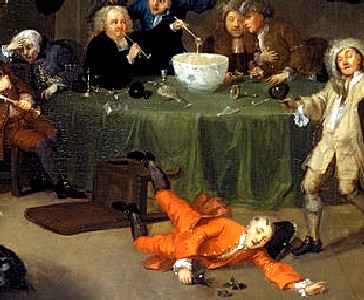
Artist: William Hogarth - A Modern Midnight Conversation Color (c. 1732)
It probably comes as no surprise that a drunken spree sometimes ended very badly - sometimes even permanently - for overindulgent sailors.
Accidents are always an issue shipboard, exponentially so when you add drunkenness to the equation. Merchant sailor Francis Rogers managed to get himself intoxicated enough on two occasions to nearly harm himself in such accidents. The first occurred in 1704 aboard the Spy Galley where he explains, "I fell off the mainyard on the ship’s gunnel [top of the side of the ship] and overboard. The yard was lowered near 1/2-mast, a drunken frolic."1 A frolic it may have been, but bouncing off the side of the ship must have smarted the next morning. Rogers second near miss occurred in 1705 aboard the William Galley, where alcohol clearly obscured his better judgment. "In a frolic and in drink, Captain Kimber and I went overboard out of the boat, with all our cloths on. (I had liked to have been drowned, for (I) could not swim.)"2
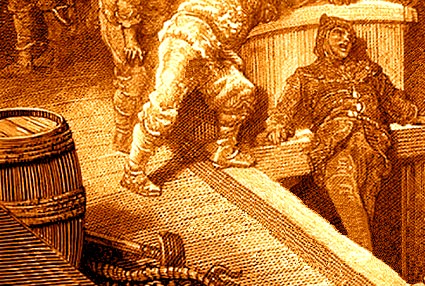
Artist: Gustave Doré - Man in Hatch, From the Rime of the Ancient Mariner (1876)
Not everyone was quite so lucky. In a proposal written to improve the Royal Navy and submitted to Charles Sergison of the Naval Office in 1702, naval physician William Cockburn explained that on fourth, fifth and sixth rate navy ships, the "hold is often open, and men get as much drink proportionable, and consequently as many accidents may happen that way."3
As proof of this, navy surgeon John Atkins recalled a sailor named Sculthop who was aboard HMS Lion in 1712, who "being very drunk, fell down the Forescuttle [hatch in the front of the ship], and fractured (its probably) this Process, his Head fell like a dead Lump to either Side, and seemed so loose, that his Face might have been turned almost behind"4.
Fellow sea surgeon James Yonge treated a Dutch sailor in 1675,
who being gotten drunk, threw himself into his Cabbin with all his Cloaths on: it unluckily fell out, that he had in his Pocket a sharp-pointed Knife, such as they usually carry, and that it lay in so ill a posture, that the weight of his body forced the point through sheath and cloaths, and run up above three inches (entring about the middle of the Thigh) obliquely towards his buttocks, so that the point might be an inch and half directly in from the skin5
Yonge withdrew the blade which resulted in a great deal of pain and bleeding. He was able to heal the man with Oil of Turpentine, bandages and blood-letting, among other things.
Alcohol tends to stir up the emotions - the more of it someone drinks, the more their emotional state is heightened. As a result, arguments and fights sometimes broke out among drunken sailors.
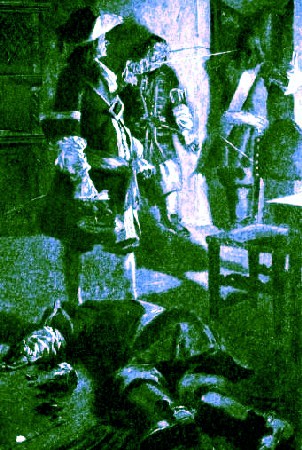
Artist: J. N. Marchand
Tavern Brawl, From Sir Henry Morgan Buccaneer, p. 41 1903)
The results were sometimes unfortunate and other times catastrophic. William Lord, the trumpeter aboard merchant captain Thomas Phillip's ship Hannibal got into an argument with one of the officers at the Royal African Company's factory at Cape Corso while they were drinking punch together. The sergeant "gave him a challenge to meet him with his sword near the redoubt, which the trumpeter promis’d, and was as good as his word; and both lugging out, it was the serjeant’s chance to be thrust into the belly; upon which he resign’d his sword, begg’d for his life, and sunk down."6 Lord was thrown thrown into the dungeon at the factory for this until it was certain that the sergeant would survive the wound.
Phillip didn't learn much from the experience. A few months later, the Hannibal's sailors brought "unpurg’d black sugar, and raw unwholesome rum they bought there [at São Tomé], of which they drank in punch to great excess"7. Once Phillips discovered this, the threw both the rum and sugar overboard, "and was forc'd to clap one Lord, our trumpeter, in irons, for his being the promoter of their unseasonable carousing bouts, and going in one of his drunken fits with his knife to kill the boatswain in his bed, and committing other enormities"8.
Alexander Hamilton, another merchant ship's captain, reported that while he was in Basra [in modern day Iraq], there broke out "a drunken Quarrel between two Sea-men of mine, wherein one was dangerously wounded with a Knife, and the other, for Fear of Punishment, turned Mahometan, being before a Portugueze Christian."9 The sailors were apparently afraid of being punished because Hamilton said the Muslim residents "are forbidden strictly the Drinking of Wine or distilled Liquors, both by their ecclesiastick and civil Laws"10. (How this would have applied to them isn't clear, but it seems a pretty drastic step so the potential punishment must have been severe.)
Nobody had a violent streak quite like the pirates, especially when they were under the influence as the following example shows.
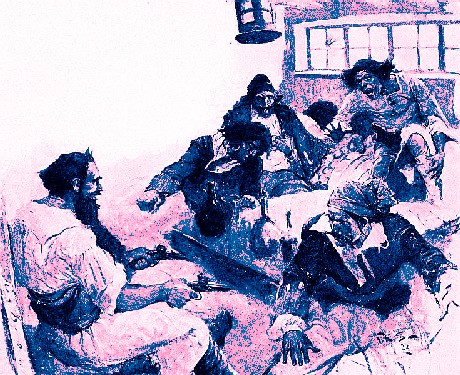
Artist: Frank E. Schoonover - Blackbeard Shooting Israel Hands (1922)
"One night drinking in his Cabin with [Israel] Hands, the Pilot, and another Man; Black-beard, without any Provocation, private draws out a small Pair of Pistols, and cocks them under the Table... When the Pistols were ready, he blew out the candle, and crossing his Hands discharged them at his Company"11. Hands was shot in the knee, forever laming him. When asked why he did this, Teach simply damned them for asking and said "if he did not now and then kill one of them, they would forget who he was."12
When pirates Olivier Levasseur, Howell Davis and Thomas Cocklyn got together on Davis' ship to discuss plans and drink, "they had like to have fallen together by the Ears [come to blows], the strong Liquor stirring up a Spirit of Discord among them, and they quarell’d"13. This was actually the impetus for breaking-up their confederation, each captain going his own way afterwards.
Drinking too much could also result in problems in keeping the ship safe and afloat.
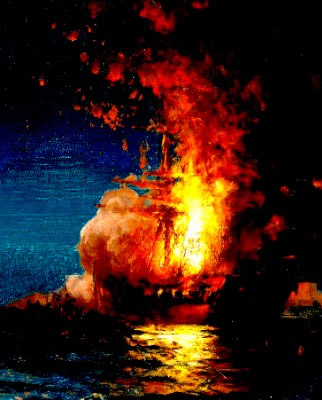
Artist: Edward Moran
Burning of the Frigate Philadelphia (c. 1897)
Captured merchant captain William Snelgrave tells of a fire that started while he was aboard Howell Davis' ship the Saint James. He notes that the crew "who were mostly drunk... they all in confusion said, 'We know not what to do in the matter:' Upon that I told them, 'If the sober People were allowed to go away with the Boats, no one would endeavour to save the Ship; and we that were left should be lost...'"14 Snelgrave suggested firing the guns on the quarter deck to signal to some small boats which had just left the ship. As a result, "all that were able, and not drunk, lent their helping hand to put out the Fire; which by this time was come to a great head in the Ship's hold."15
Snelgrave pitched in, helping to douse the fire by throwing blankets and buckets of water on it with the assistance of the 'sober' members of the crew who had returned. He notes, "There was still great Confusion amongst us, occasioned by the darkness of the Night, and the many drunken People, who were not sensible of the great Danger we were in"16. Some of the 'old hands' were rooting 'for a blast to go to Hell in' while others feared for their lives. Snelgrave himself tried to find something to throw overboard to float off upon because he couldn't swim. Fortunately, future pirate captain John (Richard) Taylor, then master of the ship, along with fifteen other men stepped up and "spared no pains to extinguish the Fire in the Hold; and tho' they were scalded in a sad manner by the Flames, yet they never shrunk till it was conquered"17.
Sometimes, the regular, drunken condition of the pirates made them careless enough that the forced men or prisoners on the ship were able to capture the ship. Four different examples of pressed men taking the ship while the pirates were intoxicated can be found in the golden age of piracy literature.
The first account of pressed men taking a pirate ship comes from John Fillmore, a forced man aboard John Phillip's pirate ship. He hatched a plan to capture the Revenge which hinged on the pirates' carousing. Fillmore explains how he went down to the ship's galley where two pirates were "drunk as beasts. I took fire and
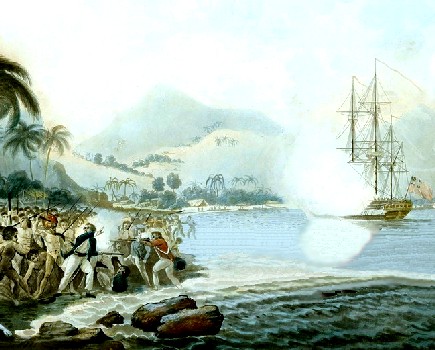
Artist: John Clevely the Younger (1787/8)
burnt these two villains in the feet, while they lay senseless, so badly as to render them unable to be upon deck next day."18 (And you though you slept soundly while under the influence.) Their burns were chalked up to an accident the next day by the nine remaining dedicated pirates. Fillmore and two other men were then able to get hold of an axe and a hammer and strategically dispatch or defeat the other nine pirates. They sailed the Revenge into Boston and surrendered her to the authorities.
The second story of pressed men taking a pirate vessel occurred when pirate Robert Culliford and his crew sailed to one of the Nicobar Islands in the Adaman Sea off India. Most of the crew went ashore to steal provisions and rape and pillage in the village, leaving only two pirates aboard their ship Josiah Ketch. With "these two drunk, James Croft, Armourer of Fort St. George... headed the Lascars [forced Indian sailors] in a successful attempt to overpower the two men and leave the Pirates."19 They took the ship to Madras, marooning Culliford and the rest of his crew on the Nicobars.
The third example of pressed men hijacking a pirate vessel is found in the capture by pirates John (Richard) Taylor and Jasper Seagar of an Ostend (Belgian) galley in 1721 off 'Mascarenhas' (Mauritius). John Freeman's account of the
capture explains that the pirates sent the galley over to St. Mary Island, Madagascar along with a Portuguese prize ship with some pirates aboard to control the prisoners. Freeman explained,
Artist: Thomas Goldsworth Dutton
East Indiaman Off Madagascar (1832)
"When she arrived we were sent to the mainland in her to cut masts for the Portuguese ship there being no suitable trees on the Island of St. Mary. There were only two Pirates left in charge of us and the ship and these having got drunk, the Dutchmen, the Portuguese and myself seized the ship and after setting the two Pirates ashore took her to Mozambique."20 The pirates never even got the opportunity to plunder that prize.
The final account of capturing a ship from the pirates concerns a Liverpool-based vessel which was taken by William Greenway "on board of which Grinnaway and the greatest part of his Hands [crew] went, and having been scant of Liquors for some time, they fell to drinking and carousing on Board the Sloop"21. The pirates left a large group of forced men on their sloop with only eight pirates to guard them. While the majority were imbibing on the Liverpool craft, the forced men "resolved to rescue themselves and make the best of their way and Leave the Pirates". One of the eight remaining pirates on the sloop saw what was happening and threatened the forced men with a pistol... and was promptly shot for his trouble. The forced men "soon Mastered and bound the rest [of the pirates], and put them into a Periyanger [perigua or canoe], but loosened the last Man to untie the rest, and Judge[d that] they saw the [Liverpool] Ship take them up."22
Of course, this strategy could work both ways. Future pirate captain Henry Every's plot to take the Charles II hinged upon the drinking habits of its captain according to Charles Johnson. Captain Gibson "was one of those who are mightily addicted to Punch... he took his usual Dose on Board [on the night of the planned mutiny], and so got to Bed before the Hour appointed for the Business."23 While the captain lay in a drunken slumber, Every and his coconspirators prepared the ship, brought up the anchor and put to sea. This eventually woke Gibson, who was told he could either join them or leave. He chose the latter, being set in one of the ship's boats along with several other crew members not willing to turn pirate.
Drunken pirates were not very good at steering their ships. Upon reaching Madagascar after coming around the
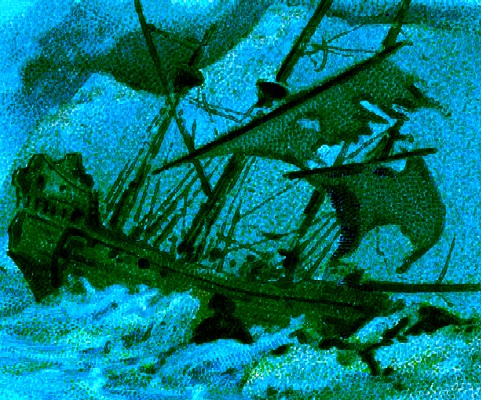
Wreck of the Whydah, From The Pirates of the Spanish Main Series
Distributed By Allen & Ginter Cigarettes (c. 1888)
southern end of Africa, Thomas White's pirates "being drunk and mad, ...knock’d their Ship on the Head [grounded it], at the South End of the Island, at a Place called by the Natives Elexa."24 As a result, several "Prisoners got to the Long-Boat, and with broken Oars and Barrel Staves... paddled to [St.] Augustin Bay; that is about 14 or 15 leagues from the Wreck where they landed, and were kindly received by the King of Bavaw"25.
Naval sailor Samuel Atkins noted in his journal that in April of 1681 a well equipped Dutch man of war which was "cast away upon Minorca, (comeing from Alicant,) which they tooke for Barcelona, being all drunck, as a few of the men that were saved, confess."26
When merchant slaver Thomas Phillips ship was coming towards Beachyhead, the headland in East Sussex, England, on June 1, 1695, his 'old drunken beast of a mate Robson' allowed the Hannibal to collide with another ship,
thro’ obstinacy and folly, refusing to bear up, or tack in time, they run aboard each other, our stemlings [forward part of the ship] in her midships, and beat her side in so, that he was forc'd to bring his ship upon the heel with his guns, to keep her from sinking, but he carry’d away our ship’s head and boltsprit, foremast and foretop mast, sunk our three boats that were a stern, and had not the Hannibal been a strong well-built old ship, 'twas enough to have sunk her too27
The Hannibal had to cut away her boats and masts to free herself from the other ship. Robson, the man "that was the occasion of it, [was found] lying dead drunk asleep upon the forecastle"28.
Sometimes the intoxicated pirates had a little assistance in wrecking their ship. Samuel Bellamy's pirates captured the
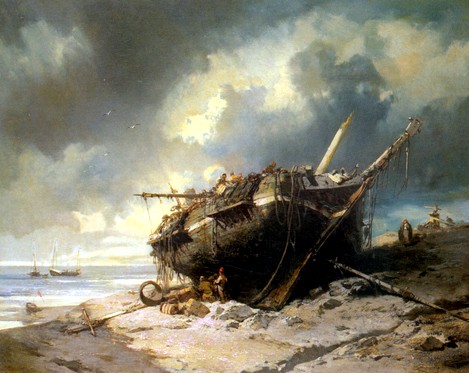
Artist: Charles Hoguet - Dismantling a Beached Shipwreck (19th c.)
Mary Anne off Cape Cod and forced the ship's master to use his ship to guide them along the coast by following his light. "He [the Mary Anne's master] upon a Night of public Rejoicing, seeing all the Pyrates drunk, laid hold of the Opportunity, and ran his Vessel ashore about Midnight, near the Land of Eastham [Massachusetts], out of which he alone escaped with his Life."29 (Johnson has this wrong; the trial accounts of the survivors count seven men who survived this wreck.30) "The Whidaw [Whydah] steering after the Light, met with the same fate"31, with only two men surviving that wreck.
Drink and tragedy sometimes went hand-in-hand for sailors. Edward Barlow reported that while the East Indiaman Septer was in port at Goa, India in 1697, "we had the misfortune to have one of our seamen drowned, being in drink, for [ar]rack being cheap everyone gets a little."32 (With some men apparently getting too much.) Captain Alexander Hamilton reported that a variety of British Men-of-War were sent to the East Indies to eradicate the pirates, but were largely unsuccessful. However,
one Scots Ship, commanded by one Millar [Miller], did the Publick more Service in destroying them, than all the chargeable Squadrons that have been sent in quest of them; for, with a Cargo of strong Ale and Brandy, which he carried to sell them, in anno 1704, he killed above 500 of them by carousing, tho' they took his Ship and Cargo as a Present from him, and his Men entered, most of them, into the Society of the Pirates.33
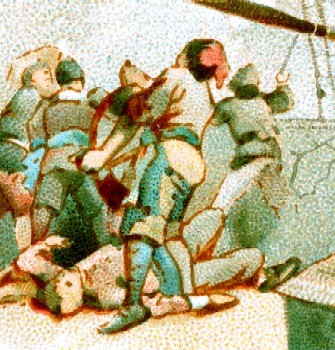
Halsey's Men Taking the Ship, From The Pirates of the Spanish
Main Series,
Distributed By Allen & Ginter Cigarettes (c. 1888)
Hamilton had some aspects of this story incorrect (a problem with many of his secondhand stories); that ship was the Scottish vessel Neptune, which was actually taken by the Madagascar-based pirates in late 1707. "Captain Miller being decoy'd ashore under Pretence of being shew'd some trees fit for Masting, [pirate captain John] Halsey invited him to a Surloin of Beef and a Bowl of Arrack Punch."34 The pirates captured Miller and his crew, took possession of the Neptune along with another ship that had been selling them liquor, the Greyhound. The pirates then took
out of the Neptune ten Pipes of Madera, with two Hogsheads of Brandy, [putting them] into the Greyhound, and putting on board the Captain, second Mate, Boatswain and Gunner of the Neptune, and about 14 of her Hands, ordered her [the Greyhound] to Sea; the rest of the Neptune’s Company being young Men fit for their Purpose, they detained, most of which, by hard drinking, fell into Distempers and died.35
This better explains why Hamilton said so many pirates died, although it was likely not 500 men, unless more deaths occurred in the pirate outpost on Madagascar before the pirates took the ship, when the Neptune and Greyhound were selling alcohol to the pirates. What 'distempers' the men died from is not made clear here. It seems more probable that they died of a variety of causes or from something contracted on Madagascar, but that is conjecture.
1 Francis Rogers. from Bruce S. Ingram's book Three Sea Journals of Stuart Times, 1936, p. 203; 2 Francis Rogers. p. 219; 3 William Cockburn, "A Method Whereby the Surgeons of His Majesty's Navy May be Made the Best in England", The Sergison Papers, p. 219; 4 John Atkins, The Navy Surgeon, 1742, p. 99; 5 James Yonge, Currus Triumpalis, é Terebinthô.,1679, p. 73; 6 Thomas Phillips, 'A Journal of a Voyage Made in the Hannibal', A Collection of Voyages and Travels, Vol. VI, Awnsham Churchill. ed., p. 207; 7,8 Phillips, p. 236; 9,10 Alexander Hamilton, British sea-captain Alexander Hamilton's A new account of the East Indies, 17th-18th century, 2002, p. 86; 12 Daniel Defoe (Captain Charles Johnson), A General History of the Pyrates, Manuel Schonhorn, ed., 1999, p. 84; 13 Defoe (Captain Charles Johnson), p. 175; 14 Captain William Snelgrave, A New Account of Some Parts of Guinea and the Slave Trade, 1734, p. 267-8; 15 Snelgrave, p. 268; 16 Snelgrave, p. 269-70; 17 Snelgrave, p. 271; 18 Ed Fox, “47. John Fillmore’s narrative”, Pirates in Their Own Words, 2014, p. 232-3; 19 Charles Grey, Pirates of the Eastern Seas (1618-1723), 1933, p. 132; 20 Grey, p. 325; 21, 22 The Boston News-Letter, Monday August 4. To Monday August 11. 1718; 23,24 Defoe (Captain Charles Johnson), p. 473; 25 Defoe (Captain Charles Johnson), p. 47; 26 Samuel Atkins, "A Sailor's Journal", Colburn's United Service Magazine, Part 1, 1854, p. 206; 27 Thomas Phillips, 'A Journal of a Voyage Made in the Hannibal', A Collection of Voyages and Travels, Vol. VI, Awnsham Churchill. ed., p.238; 28 Phillips, p. 239; 29 Defoe (Captain Charles Johnson), p. 592; 30 The Trials of Eight Persons Indited for Piracy, 1718, p. 2; 31 Defoe (Captain Charles Johnson), p. 592; 32 Edward Barlow, Barlow’s Journal of his Life at Sea in King’s Ships, East and West Indiamen & Other Merchantman From 1659 to 1703, p. 493; 33 Alexander Hamilton, A new account of the East Indies, 1746, p. 17; 34 Defoe (Captain Charles Johnson), p. 508; 35 Defoe (Captain Charles Johnson), p. 470

